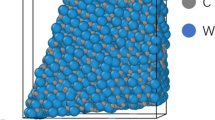Abstract
In order to reveal the wear mechanism of diamond tool in precision cutting large-aperture aluminum alloy mirror, molecular dynamics simulation is carried out in this work. The simulation results indicate that diffusion wear is the dominant way of the tool wear, which is in consistent with the cutting experiment. EDS of the aluminum alloy chips shows that Cu elements result in the phenomenon of chemical wear for diamond tool in the precision cutting process. Therefore, the wear mechanism of diamond tool in precision cutting large-aperture aluminum alloy mirror is a combination of diffusion wear and chemical wear. In addition, through the micro topography of the diamond tool wear zone, it can be found that the flank wear is the dominant form of the cutting tool. The results of the orthogonal experiment show that the influence of the tool clearance and feed rate on tool wear is greater than that of the cutting speed and tool arc radius. The results of single-factor experiment indicate that with the increase of the feed rate, the tool wear increases. While with the increase of the tool clearance, the tool wear decreases.
Similar content being viewed by others
References
Kotani M, Imai T, Katayama H, Yui Y, Tange Y, Kaneda H, Enya K (2013) Quality evaluation of spaceborne SiC mirrors (II): evaluation technology for mirror accuracy using actual measurement data of samples cut out from a mirror surface. Appl Opt 52(26):6458–6466. https://doi.org/10.1364/AO.52.006458
Shimizu Y, Goto S, Lea JC (2013) Fabrication of large-size SiC mirror with precision aspheric profile for artificial satellite. Precis Eng 37(3):640–649. https://doi.org/10.1016/j.precisioneng.2013.01.009
Li C, Zhang F, Ma Z, Ding Y (2017) Modeling and experiment of surface error for large-aperture aspheric SiC mirror based on residual height and wheel wear. Int J Adv Manuf Technol 91(1):13–24. https://doi.org/10.1007/s00170-016-9753-3
Li C, Zhang F, Meng B, Liu L, Rao X (2017) Material removal mechanism and grinding force modelling of ultrasonic vibration assisted grinding for SiC ceramics. Ceram Int 43(3):2981–2993. https://doi.org/10.1016/j.ceramint.2016.11.066
Moriwaki T (1989) Machinability of copper in ultra-precision micro diamond cutting. CIRP Ann Manuf Technol 38(1):115–118. https://doi.org/10.1016/S0007-8506(07)62664-X
Zhang SJ, To S, Zhu ZW et al (2016) A review of fly cutting applied to surface generation in ultra-precision machining. Int J Mach Tool Manu 103:13–27. https://doi.org/10.1016/j.ijmachtools.2016.01.001
Yan JW, Syoji K, Tamaki J (2003) Some observations on the wear of diamond tools in ultra-precision cutting of single-crystal silicon. Wear 255(7-12):1380–1387. https://doi.org/10.1016/S0043-1648(03)00076-0
Pramanik A, Neo KS, Rahman M (2008) Ultra-precision turning of electroless-nickel: effect of phosphorus contents, depth-of-cut and rake angle. J Mater Process Technol 208(1-3):400–408. https://doi.org/10.1016/j.jmatprotec.2008.01.006
To S, Zhu YH, Lee WB (2008) Effects of cutting depth on the surface microstructure of a Zn–Al alloy during ultra-precision machining. Appl Surf Sci 254(6):1559–1564. https://doi.org/10.1016/j.apsusc.2007.07.087
Weck M, Peschke C (2004) Equipment technology for flexible and automated micro-assembly. Microsyst Technol 10(3):241–246. https://doi.org/10.1007/s00542-003-0360-5
Cheung CF, Lee WB (2000) Study of factors affecting the surface quality in ultra-precision diamond turning. Mater Manuf Process 15(4):481–502. https://doi.org/10.1080/10426910008913001
Wang C, Cheng K, Nelson N, Sawangsri W, Rakowski R (2015) Cutting force–based analysis and correlative observations on the tool wear in diamond turning of single-crystal silicon. Proc Inst Mech Eng B J Eng Manuf 229(10):1867–1873. https://doi.org/10.1177/0954405414543316
Pretorius CJ, Soo SL, Aspinwall DK, Harden PM, MSaoubi R, Mantle AL (2015) Tool wear behaviour and workpiece surface integrity when turning Ti–6Al–2Sn–4Zr–6Mo with polycrystalline diamond tooling. CIRP Ann Manuf Technol 64(1):109–112. https://doi.org/10.1016/j.cirp.2015.04.058
Schrock DJ, Kang D, Bieler TR, Kwon P (2014) Phase dependent tool wear in turning Ti-6Al-4V using polycrystalline diamond and carbide inserts. J Manuf Sci Eng 136(4):041018. https://doi.org/10.1115/1.4027674
Abou-El-Hossein K, Olufayo O, Mkoko Z (2013) Diamond tool wear during ultra-high precision machining of rapidly solidified aluminium RSA 905. Wear 302(1):1105–1112. https://doi.org/10.1016/j.wear.2012.12.060
Zhang X, Liu K, Kumar AS, Rahman M (2014) A study of the diamond tool wear suppression mechanism in vibration-assisted machining of steel. J Mater Process Technol 214(2):496–506. https://doi.org/10.1016/j.jmatprotec.2013.10.002
Nouari M, List G, Girot F, Coupard D (2003) Experimental analysis and optimisation of tool wear in dry machining of aluminium alloys. Wear 255(7):1359–1368. https://doi.org/10.1016/S0043-1648(03)00105-4
Cheng K, Luo X, Ward R, Holt R (2003) Modeling and simulation of the tool wear in nanometric cutting. Wear 255(7):1427–1432. https://doi.org/10.1016/S0043-1648(03)00178-9
Goel S, Luo X, Reuben RL (2012) Molecular dynamics simulation model for the quantitative assessment of tool wear during single point diamond turning of cubic silicon carbide. Comput Mater Sci 51(1):402–408. https://doi.org/10.1016/j.commatsci.2011.07.052
James S, Sundaram MM (2015) Molecular dynamics simulation study of tool wear in vibration assisted nano-impact-machining by loose abrasives. J Micro Nano-Manuf 3(1):011001
Maekawa K, Itoh A (1995) Friction and tool wear in nano-scale machining—a molecular dynamics approach. Wear 188(1–2):115–122. https://doi.org/10.1016/0043-1648(95)06633-0
Shao F, Liu Z, Wan Y, Zhang B (2010) Diffusion wear for PCD tools cutting aluminum alloy ZL109 based on thermodynamics. J Tianjin Univ 43:315–321
Luo X, Liang Y, Dong S (2000) The study of molecular dynamics simulation of nanometric cutting process of single crystal Al. China Mech Eng 11:860–862
Funding
This work was supported by the National Natural Science Foundation of China (Grant no. 51675131).
Author information
Authors and Affiliations
Corresponding authors
Rights and permissions
About this article
Cite this article
Dong, G., Wang, X. & Gao, S. Molecular dynamics simulation and experiment research of cutting-tool wear mechanism for cutting aluminum alloy. Int J Adv Manuf Technol 96, 1123–1137 (2018). https://doi.org/10.1007/s00170-018-1641-6
Received:
Accepted:
Published:
Issue Date:
DOI: https://doi.org/10.1007/s00170-018-1641-6



